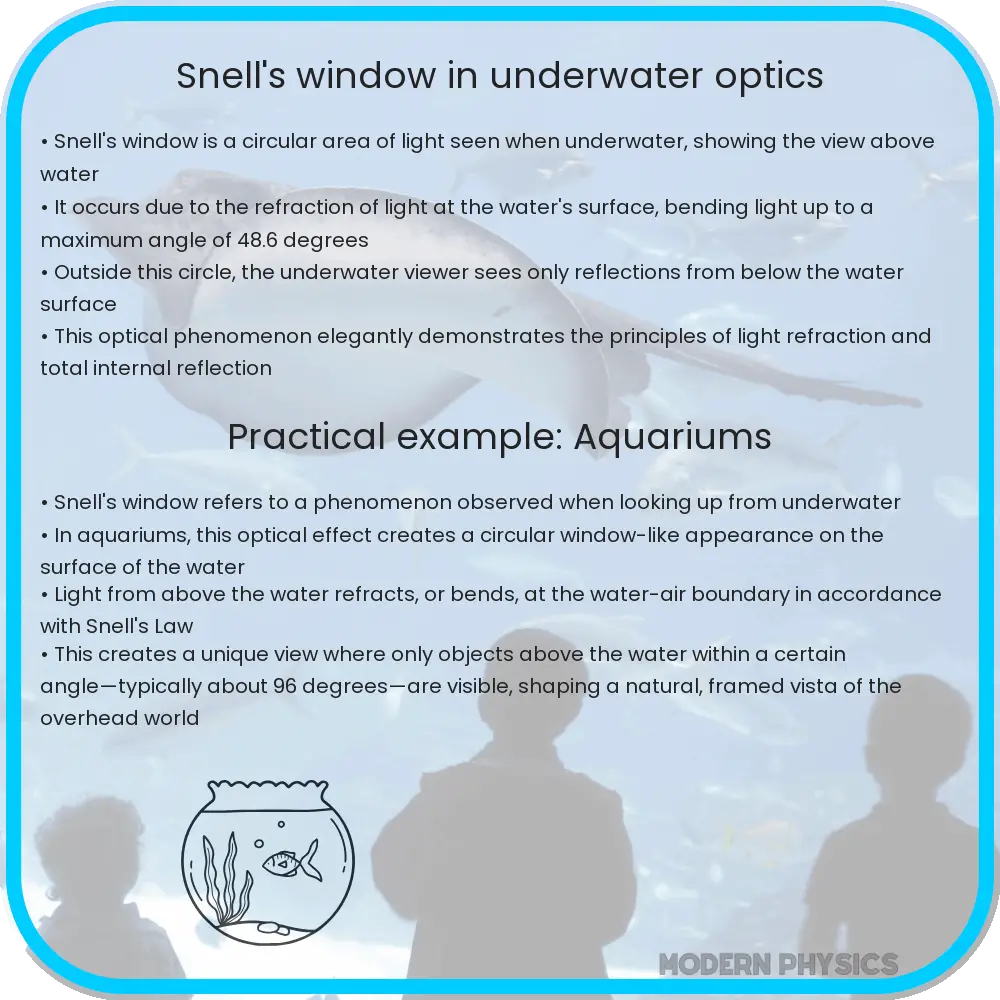Explore Snell’s Window, an underwater optical phenomenon revealing how light refraction creates a mesmerizing portal, enhancing photography and navigation.

Exploring Snell’s Window: A Fascinating Underwater Optical Phenomenon
Snell’s Window, often referred to as the optical portal or the underwater window, is a mesmerizing visual effect observed by divers and underwater photographers. This phenomenon creates a circular window-like appearance on the surface of the water when viewed from beneath. The science behind Snell’s Window is deeply rooted in the principles of refraction, a fundamental concept in physics that describes the bending of light as it passes from one medium into another of different density.
Understanding Light Refraction
At the heart of Snell’s Window is the law of refraction, commonly known as Snell’s Law. Snell’s Law quantifies the relationship between the angles of incidence and refraction, given by the equation:
n1sin(θ1) = n2sin(θ2), where n1 and n2 are the refractive indices of air and water, respectively, and θ1 and θ2 are the angles of incidence and refraction.
Visuals of Snell’s Window
The visual effect of Snell’s Window is a direct consequence of the bending of light rays as they pass from water to air. This bending causes all the underwater views, within a certain viewing angle, to be compressed into a cone of light. This cone typically spans an angle of about 97 degrees, beyond which light does not enter the water directly. The edge of this circle of light appears as a bright rim, while everything outside this cone appears darker, creating a stark contrast that enhances the window effect.
Factors Influencing Snell’s Window
Several factors can influence the appearance and clarity of Snell’s Window, including the observer’s depth, water clarity, and surface conditions. For instance, a smoother surface will produce a clearer window, while waves and ripples can distort the circular shape and introduce a shimmering effect. Additionally, the presence of suspended particles or turbidity in the water can scatter light, affecting the window’s visibility and overall visual quality.
This intriguing phenomenon not only offers a unique perspective on the underwater world but also serves as a practical demonstration of the principles of optics and light behavior. As we dive deeper into the exploration of Snell’s Window, we uncover the intricate balance between physics, nature, and the way we perceive our environment underwater.
The Role of Snell’s Window in Underwater Photography and Navigation
Snell’s Window is not just a curiosity for divers and underwater enthusiasts; it also plays a significant role in underwater photography and navigation. Photographers often leverage this natural optical phenomenon to capture stunning images that contrast the vibrant underwater life with the light-filled portal above. The effect can add depth and a sense of dimension to underwater photographs, creating a natural frame that draws the viewer’s eye to the surface.
In terms of navigation, marine animals are known to use Snell’s Window to orient themselves in relation to the water’s surface. This natural compass aids creatures in locating upward directions and can influence their behavior in seeking prey or evading predators. The understanding of this phenomenon has also aided human divers in better orienting themselves while exploring underwater realms.
Scientific and Educational Implications
Snell’s Window serves as a powerful educational tool, demonstrating the principles of light refraction in a tangible and visually striking manner. It provides a real-world application of Snell’s Law, making it an excellent subject for educational programs related to physics, optics, and marine science. By studying this phenomenon, students and enthusiasts can gain insights into the behavior of light and the interaction between different mediums, enriching their understanding of the natural world.
Conclusion
Snell’s Window is a captivating phenomenon that beautifully illustrates the interaction between light and the aquatic environment. Beyond its visual allure, it encompasses significant scientific, navigational, and photographic implications. This natural optical window not only enhances our appreciation of the underwater world’s beauty but also deepens our understanding of fundamental physical principles. Whether observed by a diver, captured through the lens of an underwater camera, or studied in a classroom, Snell’s Window opens up a portal to both the literal and metaphorical depths of our planet’s waters. It stands as a testament to the intricate and fascinating ways in which the laws of physics manifest in our natural environment, inviting us to explore and appreciate the wonders beneath the surface.
